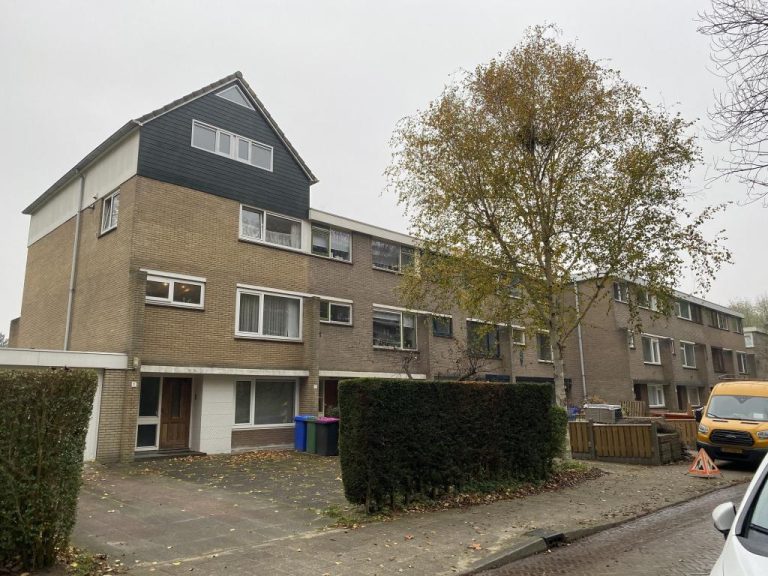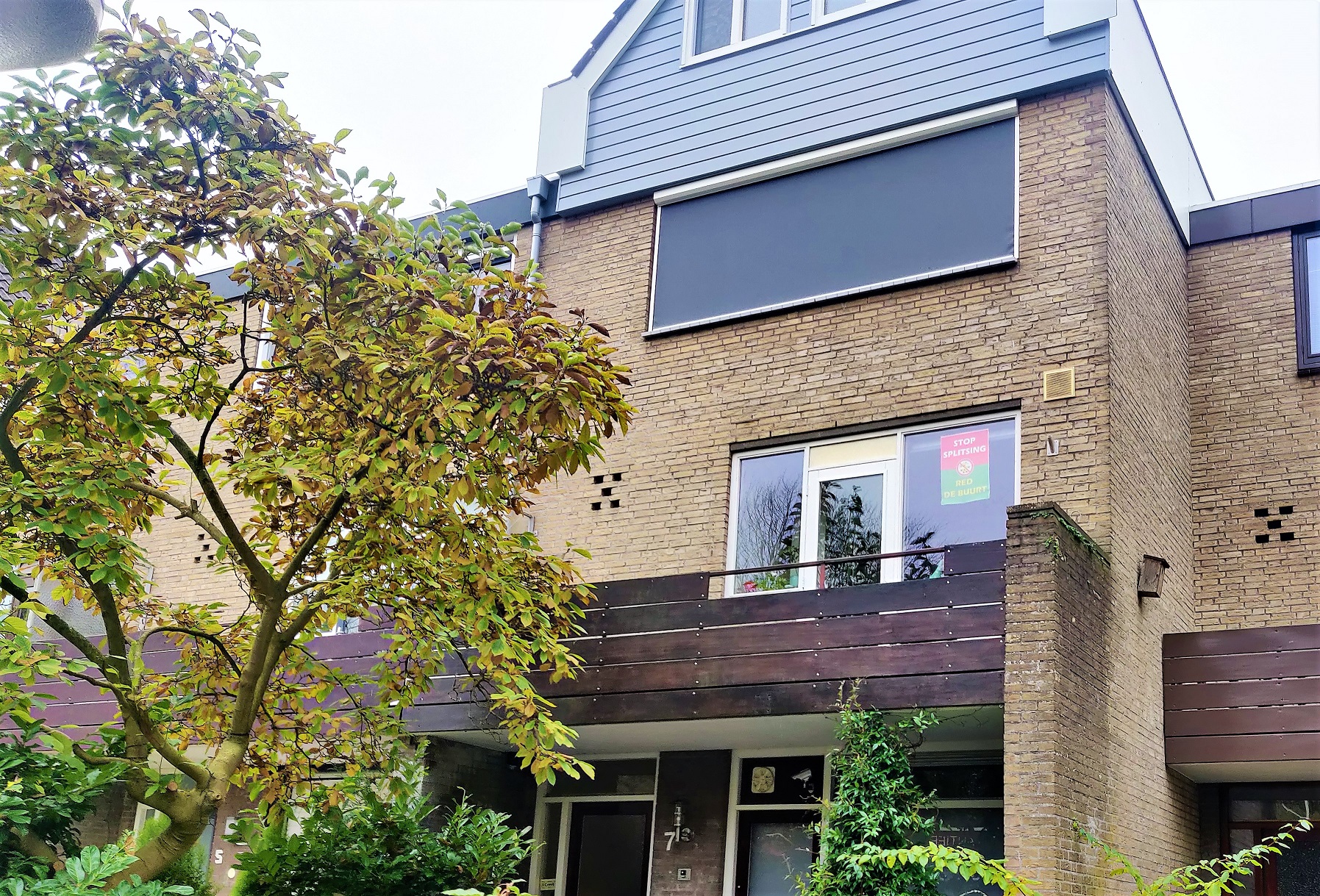First, it was no longer allowed to split up homes into student rooms; now the municipality wants to stop conversion into studios. What were and are the effects of this?
In the Antoon Coolenlaan, residents are not shy about expressing their opinions. Stop splitting houses, save the neighbourhood' says a poster on the window. (Photo: Marjolein van der Veldt)
What you will read in this article:
- After the municipality of Delft had restricted the conversion of houses into student rooms in 2017, another phenomenon emerged: subdivision of houses. Residences were no longer converted into student rooms with shared amenities, instead, owners sub-divided the residence into self-contained flats or studios.
- This is clearly shown in figures that Delta and Omroep Delft managed to obtain. The number of private rental units rose by 39.4% between 2017 and 2020 while the number of purchased houses only rose by 0.8%.
- The cause? A tight housing market combined with a municipality that did not respond fast enough to new developments. In this case, it is about investors and wealthy individuals that added to the number of small rental homes on offer by subdividing residences.
- This caused a clash of interests between the tenants of small homes (students and starters) and first-time buyers, given that they are targeting the same residences.
- The question is who will benefit from the new regulations about house division recently introduced by the municipality. This will certainly not be students.
Anyone walking into the A.M. de Jonglaan in the Voorhof neighbourhood in Delft will immediately see the effects of the anti-room conversion regulations of 2017. This is when Delft imposed an ordinance that was to definitively prevent privately owned homes from being converted into student rooms. The conversion of residences into several rooms in previous years had led to a shortage of houses for young buyers and to annoyance about the nuisance caused by students in residential neighbourhoods. Homes worth more than EUR 265,000 could no longer be converted into rooms, plus the owners needed to apply for a permit should they wish to convert anyway.
The new regulations, however, had an unforeseen effect as is visible in streets such as the A.M. de Jonglaan. Over the last few years, family homes have been sub-divided into mini-apartment blocks. The gardens of the houses that are still in their original state are green and well maintained. The front gardens of the converted houses are tiled over and serve as bicycle parkings. Builders are noisily working at numbers 7 and 9 on the next house sub-division project.
‘Doing this is helping solve the problem, isn’t it?‘
The 1960s houses consist of three floors and this makes them perfect for dividing up into three small flats. Once converting houses into rooms with shared amenities was no longer permitted, the sub-division of houses became the best way for investors and wealthy individuals to either make money from letting or to give their studying children a home. Their idea is that if we may not convert houses into student houses with several rooms and shared amenities, we will divide up the house into several self-contained studios or small apartments.
Resistance in the neighbourhood
Dividing up homes was the reason for the neighbourhood residents to dig their heels in from the start. The Voorhof II West neighbourhood association started the ‘Red De Buurt’ (save the neighbourhood) campaign in 2018. Resident Jacob Lindeijer was involved from the start. We talk to him in the back garden of one of the neighbours whose house is not yet sub-divided. “At a certain point there were so many sub-divided houses that we didn’t even know who our neighbours were anymore,” says Lindeijer. “This had a major impact. Our neighbourhood became much less liveable and lost its character. We used to have a lot of green, but most of that is gone. We would like to have more young families in our neighbourhood,” he says with resignation.
While we talk we hear the noise from the building work in numbers 7 and 9 through the open windows. The new owner is working there with his contractor. When he walks outside he talks to us, asking us to keep his identity anonymous. He believes that dividing up houses is the right thing to do and the answer to the current tight housing market. “We have a huge housing shortage. Doing this is helping solve the problem, isn’t it?”
Conflict of interest
This shows how the combination of a housing shortage and dividing up houses brings the interests of different groups into conflict. Students and other young renters benefit from more small accommodation in the city while first-time buyers are looking for family homes. This becomes a problem if both types of accommodation are to be found in the same houses.
Up to now it has mostly been young buyers who have been pushed out of the Delft housing market. Students and young renters got a bit more choice because the number of private rental homes in the cheaper neighbourhoods around the city centre increased. Omroep Delft and Delta non show this phenomenon for the neighbourhoods in areas where few new houses have been built such as Westerkwartier, Voorhof and Wippolder. The data were obtained from the delft.incijfers.nl database that compares the figures from the Central Bureau for Statistics with those of municipal databases.
As the graph shows, the rising and falling numbers in the different areas are poles apart. Still, one trend clearly emerges – the number of private rental homes is rising faster than the number of owned homes. Between 2017 and 2020, only 159 owned homes were added to Delft.
Even more so, in the areas where no new houses were built, the number of owned homes dropped, while the number of rental homes in the private housing sector rose. In total, 2,539 private rental homes were added between 2017 and 2020, an increase of 39.4%.
As an example, the number of owned homes in the Wippolder-Noord area decreased from 418 to 397 between 2017 and 2020. At the same time, the number of private rental homes rose from 187 to 223 during the same period.
What was the reason for this increase in private rental homes? When asked, the municipality of Delft made the connection to an increasing demand for student housing. One of seven sold residences over the last few years has gone to investors (source: ‘woonmonitor’, page 25, in Dutch) who would not live at the purchased addresses themselves.
‘We knew that the share of housing that went from ‘being lived in by the owner’ to private rental had significantly increased in recent years’, the municipality stated in an email. ‘We also saw a rise in the number of issued permits for house subdivision. This was about 100 permits in four years and covered buildings that were thereafter divided into three new homes in each address on average.’
The Wippolder and Westerkwartier areas in particular saw many more small flats created. In the Olofsbuurt, Wippolder-Noord and Wippolder-Zuid areas, the number of residential units of between 15 and 49 square metres rose. The number of private rental homes also rose while the number of larger houses shrank.
‘A ban on dividing up houses is not a solution in the long term‘
The municipality also saw this trend in some neighbourhoods. That is a reason that the Alderman for Housing, Karin Schrederhof, tried to stop the developments through a new housing ordinance that took effect in June 2021. To qualify for division, a residence now has to have a minimum surface area of 180 square metres and the planned studios and flats may not be smaller than 40 square metres. This will mostly discourage investors as bigger studios mean less profit.
Students will feel the pain
While this may be good news for first-time buyers, students and other young renters will feel the pain, says Ida de Boer, Chair of the municipal council party STIP. As does the investor on the A.M. de Jonglaan, she sees house division as a solution. “It is becoming ever harder for students to find a place to live. We are ignoring emerging problems.”
De Boer believes that the increasing demand for cheap rentals cannot be met at present. To her mind, the new housing ordinance can thus only be a temporary solution. “It is good to look at regulation, but a ban on dividing up houses is not a solution in the long term. We still need homes for students.”
Socialist Party Council Member Salwan al Jaberi also believes that dividing up houses is in itself not the issue. He thinks that things go wrong when investors get too much leeway, as they do now. “The premise behind dividing up large houses is not wrong in itself. Look at the large canal houses in the city centre. It is a good idea to create small apartments there,” he says. “But it is not good if it is investors who do it. They charge extremely high rents after purchasing a house.”
Late intervention
Al Jaberi sees the rising conflict of interest between young renters and first-time buyers. The renters will eventually lose out. “They won’t be able to save any money if they have to pay EUR 800 to EUR 900 in rent.” The Council Member blames the municipality that it intervened too late. He believes that the signs of increasing house division were already there after the introduction of the ban on dividing houses into rooms in 2017.
‘Student numbers will not stop increasing’
Municipality project manager Gerard van Zomeren disagrees. “Yes, we saw some signs, but it was not as though we saw the town turn upside down immediately. These sort of developments are gradual and always in line with nationwide trends. And creating new regulations must be done carefully.”
Being careful when creating regulations is mostly necessary to avoid litigation, explains Alderman Schrederhof. “If regulations are imposed too quickly, they can be deemed as disproportionate by the Council of State on the grounds of not having considered all the interests at stake.” Van Zomeren adds that “It takes time to make an ordinance legal and to check if it is right and will have the desired effect.”
 In the A.M. de Jonglaan two more houses (numbers 7 and 9) will be converted into appartments. (Photo: Merijn Kramer)
In the A.M. de Jonglaan two more houses (numbers 7 and 9) will be converted into appartments. (Photo: Merijn Kramer)
It thus took a long time before there were new regulations, but resident Jacob Lindeijer is now hopeful that the division of the houses at 7 and 9 A.M. de Jonglaan will be the last. But he still remains sceptical. “Who knows what will happen in the future. Student numbers will not stop increasing.” The question is what wealthy buyers will dream up to next to meet the demand for small homes. “Time will tell,” he says.
- This investigation came about thanks to conversations with neighbourhood residents, estate agents, advocacy groups, the municipality and the figures on delft.incijfers.nl.
- This production was made by Merijn Kramer (Omroep Delft), Annebelle de Bruijn, Marjolein van der Veldt and Saskia Bonger.



Comments are closed.